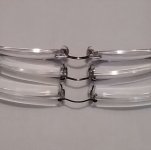CJ,
Maybe the wine was a bad choice. How about shoes? Will you be campaining for the maunfacturers to display the external length +/- 0.5mm? The internal sizing might not be perfect for everyone but surely it's a better starting point?
I've added three more binoculars to the list so size wise I'm now going from an 9x28 to a 10x56. The diameters for the highest points on the eyecups range from 33 to 42mm. My preferred available ER setting all 6 is still 11 to 12mm with a tollerance of 10 to 14mm. My prescription is fairly weak but I'm sure those with a stronger prescription most would figure out if there is a millimetre or so more leeway with a wider eyecup.
By my estimates the true ER of these are all very similar, between 18.5 and 19.5mm However the lost distance between the eyepiece lens and the lowest eyecup setting ranged from 2.5 to about 6.5mm meaning the available ER ranged from 12 to 17.5mm. With my weak prescription, close fitting, rimless glasses all are fine for me but I know you have mentioned ER issues once or twice in the past ( ). Which binocular (or measurement) do you imagine would be the best bet for you?
). Which binocular (or measurement) do you imagine would be the best bet for you?
Getting back to the MHG. I've only tried them for short while at the UK launch day. I spent more time with the 8x and I'm pretty sure I twisted out the 8x eycups a fraction but sorry, I don't remember if I did the same for the 10x. The ER is listed at 17.8 and 17.0mm respectively. From other Nikons I've tried I would guess they normally use true ER.
David
Maybe the wine was a bad choice. How about shoes? Will you be campaining for the maunfacturers to display the external length +/- 0.5mm? The internal sizing might not be perfect for everyone but surely it's a better starting point?
I've added three more binoculars to the list so size wise I'm now going from an 9x28 to a 10x56. The diameters for the highest points on the eyecups range from 33 to 42mm. My preferred available ER setting all 6 is still 11 to 12mm with a tollerance of 10 to 14mm. My prescription is fairly weak but I'm sure those with a stronger prescription most would figure out if there is a millimetre or so more leeway with a wider eyecup.
By my estimates the true ER of these are all very similar, between 18.5 and 19.5mm However the lost distance between the eyepiece lens and the lowest eyecup setting ranged from 2.5 to about 6.5mm meaning the available ER ranged from 12 to 17.5mm. With my weak prescription, close fitting, rimless glasses all are fine for me but I know you have mentioned ER issues once or twice in the past (
Getting back to the MHG. I've only tried them for short while at the UK launch day. I spent more time with the 8x and I'm pretty sure I twisted out the 8x eycups a fraction but sorry, I don't remember if I did the same for the 10x. The ER is listed at 17.8 and 17.0mm respectively. From other Nikons I've tried I would guess they normally use true ER.
David
Last edited:






